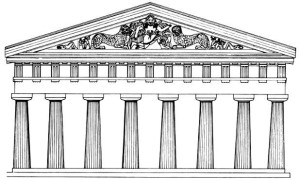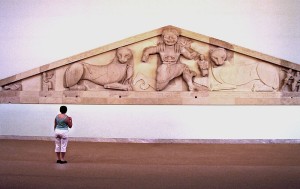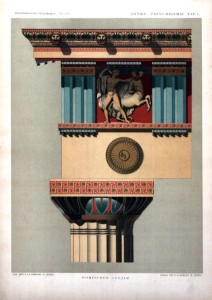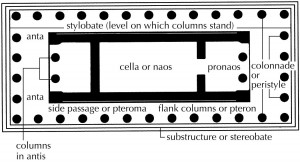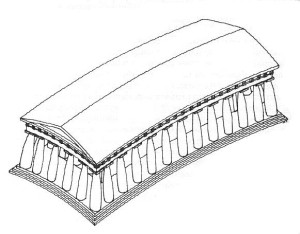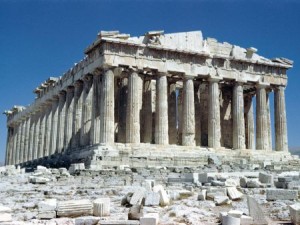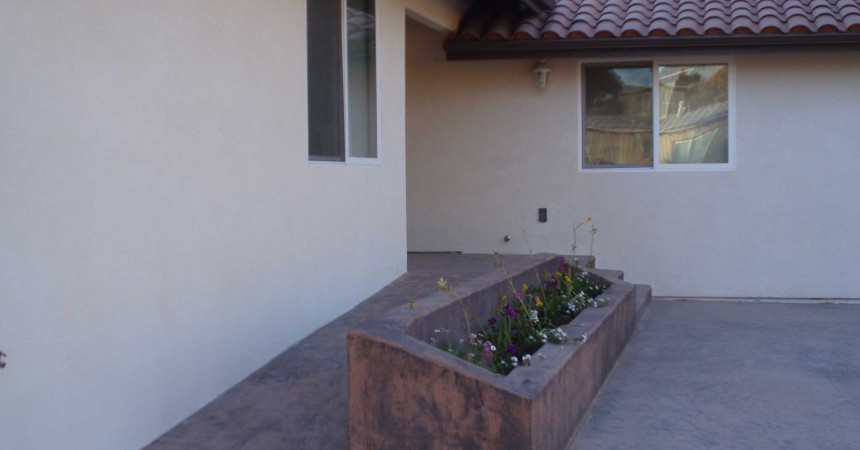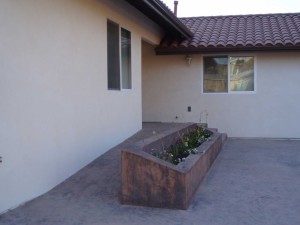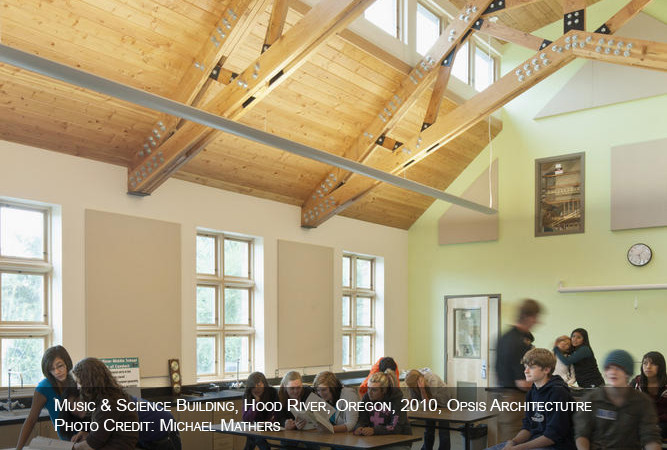
Daylighting – A Brief Look at Systems, Benefits & Costs
It feels great to get outside on a beautiful day to go on a hike, bike ride or even a lazy walk around the neighborhood. Along with exercise, much of the energy a person gains from outdoor activity comes from getting some sun -it’s great for mind, body & soul! However too much sun isn’t a good thing for your skin, so you better wear some SPF? Good indoor daylight is healthy too, both for buildings and their occupants. However, as mindful as people are of getting too much outdoor sun, attention also needs to be applied to how building interiors receive sun. Done carefully, daylight can be brought inside with many benefits, in economic, environmental, and human terms. According to the Whole Building Design Guide, daylighting is defined as “the controlled admission of natural light – direct sunlight and diffuse skylight – into a building to reduce electric lighting and saving energy. …daylighting helps create a visually stimulating and productive environment for building occupants, while reducing as much as one-third of total building energy costs.” Benefits, depending on building type and use, in clude energy savings, increased worker productivity, increased retail sales, decreased absenteeism, boosted test scores for students, and accelerated recovery for hospital patients. With all of daylighting’s benefits, it is important to be done as a holistic system that provides daylight without excessive solar heat gain or glare. If not, it is possible to see actually higher energy costs than if daylighting had not been attempted. Let’s take a brief look at some of the techniques and components of a good daylighting system.
The WBDG describes daylighting as a system consisting of “systems, technologies, and architecture” including at least one of the following:
- Daylight-optimized building footprint
- Climate-responsive window-to-wall area ratio
- High-performance glazing
- Daylighting-optimized fenestration (windows etc.) design
- Skylights (passive or active)
- Tubular daylight devices
- Daylight redirection devices
- Solar shading devices
- Daylight-responsive electric lighting controls
- Daylight-optimized interior design (such as furniture design, space planning, and room surface finishes).
The footprint of the building is a critical daylighting component that cannot be retrofitted, so it must be planned for daylighting from the beginning. An east-west building axis provides a southern exposure that maximizes energy efficient daylighting opportunities. The south-to-north depth of the building is also important because the strength of the light decreases the further is travels into a space. As an example, daylight provided by a typical arrangement of windows for an office will provide sufficient daylight for a distance of up to 15’ into a space. (From an AIA 2030 workshop presented by Ihab Elzeyadi, Ph.D, FEIA, LEED AP, University of Oregon’s Department of Architecture). As additional daylighting components and strategies are added to the building design, daylighting can be effective for up to 60’ of floor depth south-to-north. Let’s break down a daylighting system and look at the individual components.
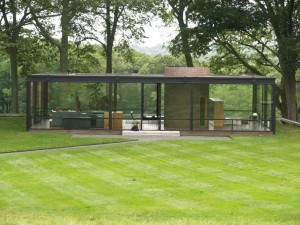
Dramatic, but not necessarily good daylighting strategy. The 1949 Philip Johnson Glass House would be difficult to pass current Title-24 energy requirements. The glazing must be around R2, but I’ll have to research that. Located in New Canaan Connecticut, I would like o know what it was like in the winter. My guess: beautiful but maybe a bit chilly until the fireplace got roaring.
http://en.wikipedia.org/wiki/File:Glasshouse-philip-johnson.jpg
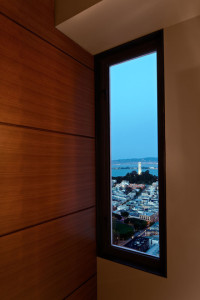
Small windows can frame great views. View of San Francisco’s Coit Tower. Russian Hill Apartment, Zack de Vito Architecture + Construction, Photo credit: Bruce Damonte, http://www.zackdevito.com/markets/1-live/projects/48-russian-hill-high-rise
Windows are an obvious source of sunlight, but not always looked at as a daylighting component. Strategies for windows are critical to the effectiveness of the daylighting system. Many factors apply to windows and their placement – perhaps the most important is the window-to-wall area ratio because windows have very little insulating value compared to wood wall framing. Typical dual-pane window R-values range from R2 to R4, while 2×6 wood wall framing is typically insulated to R19. Large areas of glazing will let in a lot of light, but the building’s HVAC system will have to work hard to maintain comfortable indoor temperatures. Windows can be categorized in two ways – view windows and daylight-emitting windows. View windows are important to occupant satisfaction. According to Elzeyadi, “Those in offices with highly rated views used 20% less hours of sick leave.” “Employees used 30% less sick leave in offices with high daylighting quality.” Great views do not necessarily need to rely on large, energy-inefficient windows – smaller windows that frame views can add drama and demonstrate sophistication. Daylighting windows are usually placed high in walls, sometimes over view windows and are usually referred to as clearstory windows. Solar orientation is an
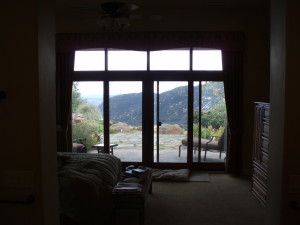
Large windows are most energy efficient on south-facing facades. Pala-Temecula House, 2003, MS|Architecture, Photo: Micah Smith
important factor when sizing and placing both view and daylighting windows. Energy Star labels on windows highlight other important factors: U-factor, Solar Heat Gain Coefficient, Visible Transmittance, and Air Leakage. These performance ratings should be matched to climate, solar orientation, and whether the window’s purpose is view or daylighting. Elzeyadi includes windows in a category called Side Lighting, where Top Lighting consists of skylights, roof monitors and other overhead daylight sources.
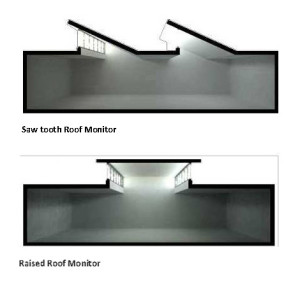
Saw tooth and raised roof monitors. http://www.public.asu.edu/~kroel/www558/Supriya%20and%20Kavish%20assign%203.pdf
Top lighting components like skylights and tubular daylight devices are familiar and often used in residential construction. However skylights are also great choices for retail and industrial buildings, especially “big-box” single story buildings. A PGE study of a major big-box retailer found skylights could be attributed to as much as a 40% increase in sales. Customers who were interviewed identified skylit stores as “airy, clean feeling,” and may tend to spend more time shopping. Another more obvious economic benefit of skylights is energy savings because of reduced reliance on artificial lighting. The same benefits also apply to smaller retail spaces. Skylights have a reputation for leaking, but modern skylights are quite reliable when correctly installed. Also they can be insulated with dual layers of glazing and some are operable for ventilation. Tubular daylighting devices are another great option. They require less space, are easily retrofitted to existing structures, and some models incorporate exhaust fans and electrical lights for night use. On a different scale, atria can facilitate large, dramatic daylit spaces. Width-to-height proportions, overall height, and interior layout and finishes are important factors to atrium design. Roof monitors are another option, if a bit less common than skylights. Actually in the first half of the 20th century roof monitors were widely used in large industrial buildings. In the 1950s cheap fluorescent lighting and air-conditioning reduced the need for daylighting and roof monitors became obsolete. Having regained some popularity, roof monitors are usually incorporated into the roof structure and help define the architectural form of a building. They are often arranged with one or more rows of sawtooth-profiled ridges – each having a sloped side and a north-facing vertical side where windows are placed. As with windows, sun angles and solar orientation are important factors for roof monitors.
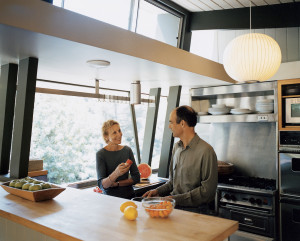
Good use of clearstory, lightshelf, and reflective ceiling and wall finishes. Los Angeles, Architects: A. Quincy Jones, Whitney R. Smith, Cory Buckner, Architect, 2004, Photo: Darcy Hemley http://www.dwell.com/house-tours/slideshow/mutual-fulfilment#4
Regulating daylight quantity and quality is critical, as is solar heat gain. Direct summer daylight can be blocked with shading devices, which in turn, allow direct winter daylight in to provide more direct daylight and warmth. As with windows, studies of sun angles and solar orientation can inform the design of correct type, size and placement of shading devices. Common types of shading devices include roof overhangs, awnings, vertical fins, and louvers. Roof monitors can received these treatments as well. Landscaping such as trees are also useful when placed strategically with respect to solar orientation and window location. Deciduous trees keep leaves in the summer providing shade, while in the winter the loss of leaves provides direct daylight and solar heat. Direct daylight that is brought into a space through clearstory windows can be redirected by lightshelves or interior louvers that bounce light off the ceiling. This will reduce glare and increase ambient daylight further into the space.
Daylighting-responsive electric lighting controls are critical to a daylighting system’s performance. Zoned lighting, dimmers, and photocell censors allow electrical lighting to dim or turn off when daylight is sufficiently illuminating a space. A study of office buildings by the American Council for an Energy-Efficient Economy shows that by “adding dimmable ballasts, photosensors, and occupancy controls where appropriate, with network components,” lighting energy consumption can be reduced by 50% or more. The study assumes an additional energy savings of 20% for reduced cooling loads due to lower light fixture-generated heat.
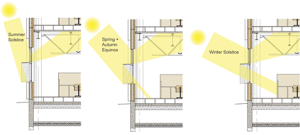
Circulation space adjacent to south-facing wall. Illustration by RNL Design. http://www.wbdg.org/resources/daylighting.php
As a daylighting component, interior design may be less obvious but it is significant. The WBDG lists furniture design, placement, and room surface finishes as important daylighting considerations. As an example, office cubicles that are shorter or that have transparent upper dividers help light travel deeper into office spaces. Also consider having circulation space near bright, south-facing windows, rather than locating workspaces directly under them. This will reduce the need for shading devices and will provide better light levels for those workspaces. In terms of interior finishes, light/glossy surfaces reflect light, and dark/matte surfaces absorb light. Ceilings are the most important surface for reflecting light, and floor reflectance is least important.
Because daylighting is a holistic system, all components must be correctly set up and maintained for the life of the building. The WBDG states that improper system installation & setup, referred to as commissioning, “is the most common reason for a daylighting system to fail.” For example, correct setup and maintenance of the daylight-responsive lighting controls will provide the energy savings they were designed to deliver. Landscape design and maintenance also play a role. This requires that building owners, occupants, and maintenance personnel are familiar with the intent and proper use of the entire daylighting system.
Lighting accounts for 17% of electrical consumption in the residential and commercial sectors, according to the US Energy Information Administration. Broken down by sector, those numbers are 13% for residential and 21% for commercial. Those energy costs can be reduced by 50% or more quite easily according to ACE3. Benefits can be accounted for in terms of increased sales, worker productivity, occupant health, and reduced resource utilization. But what does achieving those benefits cost a building owner? The answer will vary widely for every project depending mostly on choices made early on in the design. Reducing a window size reduces cost; a window glazing treatment will add cost. Providing a south-facing façade may not cost anything, or it may not be feasible at all. The ACE3 study is based on a $0.75/s.f. -incremental cost estimate for daylight-responsive lighting controls that generate lighting-related energy savings of 50% or more. A well-defined budget is critical to have in place before any design takes place. Preliminary cost estimates for a building construction can and should be prepared after the design, design development, and construction document phases, although I have not seen it done regularly in practice. Building maintenance costs can also be estimated. I welcome the opportunity to include this service in any project, but it requires coordination of the owner, design team (architect, engineers) and contractor from the beginning. From a developer perspective, marketplace considerations should be weighed against cost. Often tenants will pay more for a high-performing lease space.
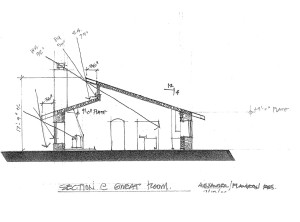
Solar study for a residence by Paul Poirier + Associates, Architects, used with permission from Paul Poirier, Architect www.poirierandassociates.com
While daylighting is an important architectural design concept, the strategies used must be carefully applied to the overall project in a way that feels natural and unforced. The daylighting components chosen and how they are used should be appropriate to a particular client, style, location, climate, budget and other factors that inform the overall design, creating a building unique to its circumstance. If you have any questions about daylighting or have a project to discuss, please contact me – I look forward to hearing from you!


